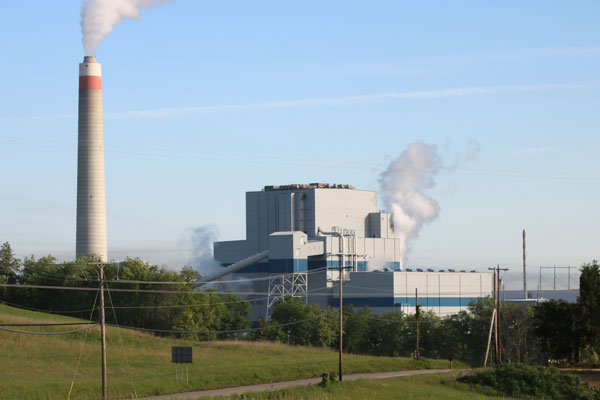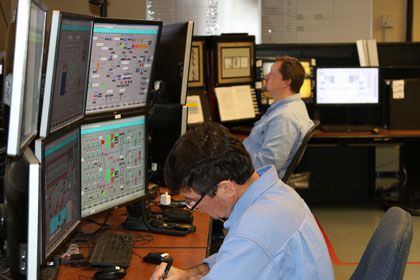Success Stories
From The Leader in Clean Power Production Technologies
Longview Power: Maidsville, WV

Titanium® Intelligent Sootblowing System Improves Performance
Plant Name
Longview Power
Location
Maidsville, West Virginia
Boiler Specifications
Capacity: 700 MW advanced supercritical
Fuel: High-sulfur coal
Boiler OEM: Foster Wheeler
Configuration: Wall fired
Commissioned: December 2011
B&W’s Titanium® intelligent sootblowing has allowed Longview Power to eliminate the need for periodic load drops, reduced sootblower usage, reduced reheat spray flow, improved unit heat rate, and stabilized unit operations.
Boiler Cleaning System
Longview has 52 Diamond Power® IR sootblowers for cleaning the furnace walls and 70 Diamond Power long-retractable IK sootblowers to clean the convection pass tube sections. The unit also has four air heater sootblowers. Steam is used as the sootblowing medium for all blowers which are controlled by the Diamond Power SentrySeries™ control system. (Note: SentrySeries controls are now integrated into the Titanium control system offerings.)
Problem/Situation
The original sootblower mode of operation on this unit was based on pre-determined sequences of sootblowers on specified timing intervals and resulted in tube erosion and excessive slag buildup. The slag buildup was most pronounced in the platen superheater and finishing superheater as well as on the nose slope. To control the slag buildup, plant operators would periodically drop load to shed the excess slag. The large slag falls would damage the lower furnace slopes and submerged flight conveyor. These large slag falls were also responsible for periodic unit trips due to furnace pressure swings.
The plant experienced other issues resulting from these sootblowing procedures. The unit would exhibita noticeable swing in operation when the furnace walls would go from heavily loaded to clean after the furnace sootblowers operated. The heavily loaded operation was accompanied by an increase in reheat spray flow which negatively impacted unit heat rate. Additionally, the furnace sootblowing activity caused erosion around the wall sootblowers which required frequent pad welding to repair. The unit would also exhibit swings in operation due to the variation in sootblowing practices between the different operating shifts. Plant operations and engineering departments had to constantly observe the growth of the deposits and balance between full load operation, cleaning frequency, and operational stability.
Solution
Babcock & Wilcox (B&W) was hired to evaluate the unit for potential rehabilitation. B&W performed testing of the unit and reviewed all aspects of operations. Along with other findings and recommendations, B&W recommended employing an intelligent sootblowing system to help improve unit operations and stability by providing better, more consistent heat transfer management.
B&W Scope
B&W’s Titanium intelligent sootblowing is a performance-based system which uses actual heat transfer performance of the furnace and each tube bank to direct sootblowing operations. The system integrates with all sootblower control systems and is designed for fully automatic sootblower operation.
The Titanium system is composed of three major components:
1) a detailed boiler performance model,
2) a robust expert system, and
3) a full-featured queuing system.
The boiler performance model is based on B&W’s boiler design standards. The performance model uses measured operational data and the design of the boiler to calculate cleanliness factors for the furnace and each heat transfer section. The model also calculates other important measures such as furnace exit gas temperature (FEGT), boiler efficiency, and heat rate.
The performance model output and plant operational data is sent to the expert system which allows different cleaning strategies for specific areas of the furnace and convection pass.
Once the expert system determines cleaning is needed in an area of the boiler, the sootblowers from that area are sent to the Titanium sootblowing queue for operation. The queue dynamically orders and operates the sootblowers based on a combination of blower effectiveness and time since last operation.
Results
Unit improvements and benefits since the Titanium system went online include:
- No load drops required to shed slag
- No large slag falls
- No forced outages from pressure swings
- Overall reduction in sootblower operation
- Improved unit stability across all loads and operating shifts
- Significantly reduced manual blower operation
Additional measured results include:
- Unit cleanliness factors have been maintained despite a decrease in sootblower operation.
- Both platen inlet gas temperature (PIGT) and FEGT have shown a slight improvement (lower temperature) with the Titanium system in full operation.
- Reduced reheat spray flow which was accompanied by an improvement in unit heat rate.
The Titanium intelligent sootblowing system was installed to help control slag accumulation and improve unit operations and stability. The system was configured to run a real-time, detailed boiler performance model to determine the heat absorption throughout the unit. The system was also configured to control pairs of blowers in seven different cleaning regions. Each cleaning region was configured with its own cleaning strategy using the Titanium expert system. Once in full operation, the Titanium system eliminated the need for periodic load drops, reduced sootblower usage, reduced reheat spray flow, improved unit heat rate, and stabilized unit operations.
